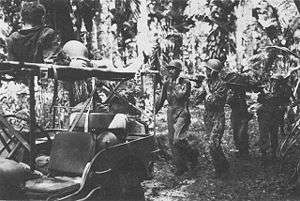New Georgia counterattack
| New Georgia counterattack | |||||||
|---|---|---|---|---|---|---|---|
| Part of the Pacific Theater of World War II | |||||||
 Injured U.S. Army soldiers are evacuated through the jungle on New Georgia on 12 July 1943 a few days before the Japanese counterattack. | |||||||
| |||||||
| Belligerents | |||||||
|
|
| ||||||
| Commanders and leaders | |||||||
|
William Halsey Millard Harmon Theodore S. Wilkinson Leonard F. Wing Oscar Griswold J. Lawton Collins |
Minoru Sasaki Genjiro Hirata | ||||||
| Strength | |||||||
| 30,000 | 9,000 | ||||||
The New Georgia counterattack was a counterattack on 17–18 July 1943 by mainly Imperial Japanese Army troops against United States Army forces during the New Georgia Campaign in the Solomon Islands. The U.S. and its allies were attempting to capture an airfield constructed by the Japanese at Munda Point on New Georgia.
The Americans landed on New Georgia on 2 July 1943 and made limited gains in their drive toward Munda Point. The objective of the Japanese counterattack was to destroy the American forces on New Georgia by attacking their exposed flank and rear areas. The Japanese succeeded in infiltrating and attacking several isolated outposts in the American rear areas, but failed to inflict significant casualties on the American forces. After the Japanese counterattack was defeated, the Americans and their allies captured the airfield in the Battle of Munda Point.
Notes
References
- Altobello, Brian (2000). Into the Shadows Furious. Presidio Press. ISBN 0-89141-717-6.
- Feldt, Eric Augustus (1946 (original text), 1991 (this edition)). The Coastwatchers. Victoria, Australia: Penguin Books. ISBN 0-14-014926-0. Check date values in:
|date=(help) - Hammel, Eric M. (1999). Munda Trail: The New Georgia Campaign, June-August 1943. Pacifica Press. ISBN 0-935553-38-X.
- Hayashi, Saburo (1959). Kogun: The Japanese Army in the Pacific War. Marine Corps. Association. ASIN B000ID3YRK.
- Horton, D. C. (1970). Fire Over the Islands. ISBN 0-589-07089-4.
- Lord, Walter (2006) [1977]. Lonely Vigil; Coastwatchers of the Solomons. New York: Naval Institute Press. ISBN 1-59114-466-3.
- McGee, William L. (2002). The Solomons Campaigns, 1942-1943: From Guadalcanal to Bougainville--Pacific War Turning Point, Volume 2 (Amphibious Operations in the South Pacific in WWII). BMC Publications. ISBN 0-9701678-7-3.
- Morison, Samuel Eliot (1958). Breaking the Bismarcks Barrier, vol. 6 of History of United States Naval Operations in World War II. Castle Books. 0785813071.
- Radike, Floyd W. (2003). Across the Dark Islands: The War in the Pacific. ISBN 0-89141-774-5.
- Rhoades, F. A. (1982). A Diary of a Coastwatcher in the Solomons. Fredericksburg, Texas, U.S.A.: Admiral Nimitz Foundation.
- Rottman, Gordon L.; Dr. Duncan Anderson (consultant editor) (2005). Japanese Army in World War II: The South Pacific and New Guinea, 1942-43. Oxford and New York: Osprey. ISBN 1-84176-870-7. Cite uses deprecated parameter
|coauthors=(help)
External links
- Craven, Wesley Frank; James Lea Cate. "Vol. IV, The Pacific: Guadalcanal to Saipan, August 1942 to July 1944". The Army Air Forces in World War II. U.S. Office of Air Force History. Retrieved October 20, 2006.
- Hoffman, Jon T. (1995). "New Georgia" (brochure). FROM MAKIN TO BOUGAINVILLE: Marine Raiders in the Pacific War. Marine Corps Historical Center. Retrieved 2006-11-21.
- Lofgren, Stephen J. Northern Solomons. The U.S. Army Campaigns of World War II. United States Army Center of Military History. p. 36. Retrieved October 18, 2006.
- Melson, Charles D. (1993). "UP THE SLOT: Marines in the Central Solomons". WORLD WAR II COMMEMORATIVE SERIES. History and Museums Division, Headquarters, U.S. Marine Corps. p. 36. Retrieved September 26, 2006.
- Mersky, Peter B. (1993). "Time of the Aces: Marine Pilots in the Solomons, 1942-1944". Marines in World War II Commemorative Series. History and Museums Division, Headquarters, U.S. Marine Corps. Retrieved October 20, 2006.
- Miller, John, Jr. (1959). "CARTWHEEL: The Reduction of Rabaul". United States Army in World War II: The War in the Pacific. Office of the Chief of Military History, U.S. Department of the Army. p. 418. Retrieved October 20, 2006.
- Rentz, John (1952). "Marines in the Central Solomons". Historical Branch, Headquarters, U.S. Marine Corps. Retrieved May 30, 2006.
- Shaw, Henry I.; Douglas T. Kane (1963). "Volume II: Isolation of Rabaul". History of U.S. Marine Corps Operations in World War II. Retrieved 2006-10-18.
- United States Army Center of Military History. "Japanese Operations in the Southwest Pacific Area, Volume II - Part I". Reports of General MacArthur. Retrieved 2006-12-08.- Translation of the official record by the Japanese Demobilization Bureaux detailing the Imperial Japanese Army and Navy's participation in the Southwest Pacific area of the Pacific War.